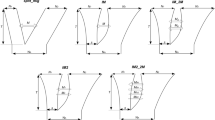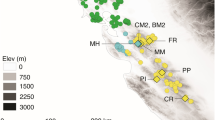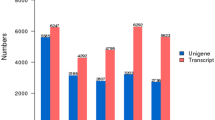Abstract
Modification of the fitness of diazinon resistance genotypes of the Australian sheep blowfly, Lucilia cuprina, in the absence of the insecticide from SS > RS > RR to SS = RS = RR (McKenzie et al., 1982) has been shown previously to be due to the segregation of a gene(s) on chromosome III (McKenzie and Purvis, 1984). In this study the gene (gene complex) is mapped to the w locus region of that chromosome by comparing changes in frequency of SS individuals in population cages initiated with RS genotypes segregating for field derived regions of chromosome III. Comparison of percentage egg hatch, the percentage of first instar larvae reaching adulthood and the time of development from egg to adult for combinations of modifier and resistance genotypes show that the modifier affects only the latter. Developmental time is decreased for RS and RR genotypes. The effect is dominant. The developmental time of SS genotypes is unaffected by modifier genotype.
Similar content being viewed by others
Article PDF
References
Abedi, Z H, and Brown, A W A. 1960. Development and reversion of DDT-resistance in Aedes aegypti. Can J Genet Cytol, 2, 252–261.
Amin, A M, and White, G B. 1984. Relative fitness of organophosphate-resistant and susceptible strains of Culex quinquefasciatus Say (Diptera: Culicidae). Bull Entomol Res, 74, 591–598.
Beeman, R W, and Nanis, S M. Malathion resistance alleles and their fitness in the red flour beetle (Coleoptera: Tene-brionidae). J Econ Entomol, 79, 580–587.
Brown, A W, and Pal, R. 1971. Insecticide Resistance in Arthropods W.H.O., Geneva.
Charlesworth, B. 1979. Evidence against Fisher's theory of dominance. Nature, 278, 848–849.
Clarke, G M, and McKenzie, J A. 1987. Developmental stability of insecticide resistant phenotypes in blowfly; a result of canalizing natural selection. Nature, 325, 345–346.
Fisher, R A. 1958. The Genetical Theory of Natural Selection, 2nd edition. Dover, New York.
Foster, G G, Whitten, M J, Konovalov, C, Arnold, J T A, and Maffi, G. 1981. Autosomal genetic maps of the Australian sheep blowfly, Lucilia cuprina dorsalis R-D (Diptera: Calliphoridae) and possible correlations with the linkage maps of Musca domestica L. and Drosophila melanogaster (Mg.). Genet Res, 37, 55–69.
Georghiou, G P. 1969. Genetics of resistance to insecticides in houseflies and mosquitoes. Exp Parasitol, 26, 224–255.
Georghiou, G P. 1972. The evolution of resistance to pesticides. AnnRev Ecol Syst, 3, 133–168.
Helle, W. 1965. Resistance in the acarina: mites. Adv Acarol, 2, 71–93.
Hotson, I K. 1985. New developments in nematode control: the role of the animal health products industry. In Anderson, N. and Waller, P. J. (eds.) Resistance in Nematodes to Anthelmintic Drugs, CSIRO and Australian Wool Corporation, Sydney, pp. 117–125.
Hughes, P B, and Devonshire, Al L. 1982. The biochemical basis of resistance to organophosphorus insecticides in the sheep blowfly, Lucilia cuprina. Pestic Biochem Physiol, 18, 289–297.
Hughes, P B, and McKenzie, J A. 1986. Insecticide resistance in the Australian sheep blowfly, Lucilia cuprina: speculation, science and strategies. In Fundamental and Practical Approaches to Combating Resistance Proc Soc Chem Industry, London (In Press).
Lewontin, R C. 1974. The Genetic Basis of Evolutionary Change Columbia Uni. Press, New York.
Maynard Smith, J, Burian, R, Kauffman, S, Alberch, P, Campbell, J, Goodwin, B, Lande, R, Raup, D, and Wolpert, L. 1985. Developmental constraints and evolution. Quart Rev Biol, 60, 266–287.
McEnroe, W D, and Naegle, J A. 1968. The coadaptive process in an organophosphorus-resistant strain of the two spotted mite, Tetranychus urticae. Ann Entomol Soc Amer, 61, 1055–1069.
McKenzie, J A. 1983. The evolution of insecticide resistance: consequences for control programmes. In 2nd National Symposium on Sheep Blowfly and Flystrike in Sheep Department of Agriculture, N.S.W., pp. 222–231.
McKenzie, J A. 1984. Dieldrin and diazinon resistance in populations of the Australian sheep blowfly, Lucilia cuprina, from sheep-grazing areas and rubbish tips. Aust J Biol Sci, 37, 367–374.
McKenzie, J A, and Purvis, A. 1984. Chromosomal localisation of fitness modifiers of diazinon resistance genotypes of Lucilia cuprina. Heredity, 53, 625–634.
McKenzie, J A, Dearn, J M, and Whitten, M J. 1980. Genetic basis of resistance to diazinon in Victorian populations of the Australian sheep blowfly, Lucilia cuprina. Aust J Biol Sci, 33, 85–95.
McKenzie, J A, Whitten, J J, and Adena, M A. 1982. The effect of genetic background on the fitness of diazinon resistance genotypes of the Australian sheep blowfly, Lucilia cuprina. Heredity, 49, 1–9.
Prout, T. 1971. The relation between fitness components and population prediction in Drosophila. 1. The estimation of fitness components. Genetics, 68, 127–149.
Roush, R T, and Croft, B A. 1986. Experimental population genetics and ecological studies of pesticide resistance in insects and mites. In Pesticide Resistance: Strategies and Tactics for Management National Academy Press, Washington, pp. 257–270.
Roush, R T, and McKenzie, J A. 1987. Ecological genetics of insecticide and acaricide resistance. Ann Rev Entomol, 32, 361–380.
Van Valen, L. 1962. A study of fluctuating asymmetry. Evolution, 16, 125–142.
Waddington, C H. 1957. The Strategy of the Genes Allen and Unwin, London.
Waddington, C H, Graber, H, and Woolf, B. 1957. Isoalleles and the response to selection. J Genet, 55, 246–250.
Whitehead, J R, Roush, R T, and Norment, B R. 1985. Resistance stability and coadaptation in diazinon-resistant house flies (Diptera: Muscidae). J Econ Entomol, 78, 25–29.
Whitten, M J, Dearn, J M, and McKenzie, J A. 1980. Field studies on insecticide resistance in the Australian sheep blowfly, Lucilia cuprina. Aust J Biol Sci, 33, 725–735.
Whitten, M J, Foster, G G, Arnold, J T, and Konovalov, C. 1975. The Australian sheep blowfly, Lucilia cuprina. In King, R. C. (ed.) Handbook of Genetics, Vol. 3, Plenum, New York, pp. 401–418.
Author information
Authors and Affiliations
Rights and permissions
About this article
Cite this article
McKenzie, J., Game, A. Diazinon resistance in Lucilia cuprina; mapping of a fitness modifier. Heredity 59, 371–381 (1987). https://doi.org/10.1038/hdy.1987.145
Received:
Issue date:
DOI: https://doi.org/10.1038/hdy.1987.145
This article is cited by
-
Identification, analysis, and linkage mapping of expressed sequence tags from the Australian sheep blowfly
BMC Genomics (2011)
-
Associations between environmental stress, selection history, and quantitative genetic variation in Drosophila melanogaster
Genetica (2006)
-
Selection at the diazinon resistance locus in overwintering populations of Lucilia cuprina (the Australian sheep blowfly)
Heredity (1994)
-
Modification of developmental instability and fitness: Malathion-resistance in the Australian sheep blowfly,Lucilia cuprina
Genetica (1993)
-
Measuring fitness and intergenic interactions: The evolution of resistance to diazinon inLucilia cuprina
Genetica (1993)



